Water resistance numbers on your swimming watch indicate how much static pressure the watch can handle in laboratory conditions, not the actual depth you can safely take it underwater. A 3 ATM rating suits hand washing and light splashes, while 5 ATM allows showering and casual swimming. For serious swimming and snorkeling, you’ll need at least 10 ATM, and professional water sports require 20+ ATM ratings to handle the dynamic pressures and movement forces that greatly exceed static testing conditions.
Understanding ATM, Meters, and Bars in Water Resistance Ratings
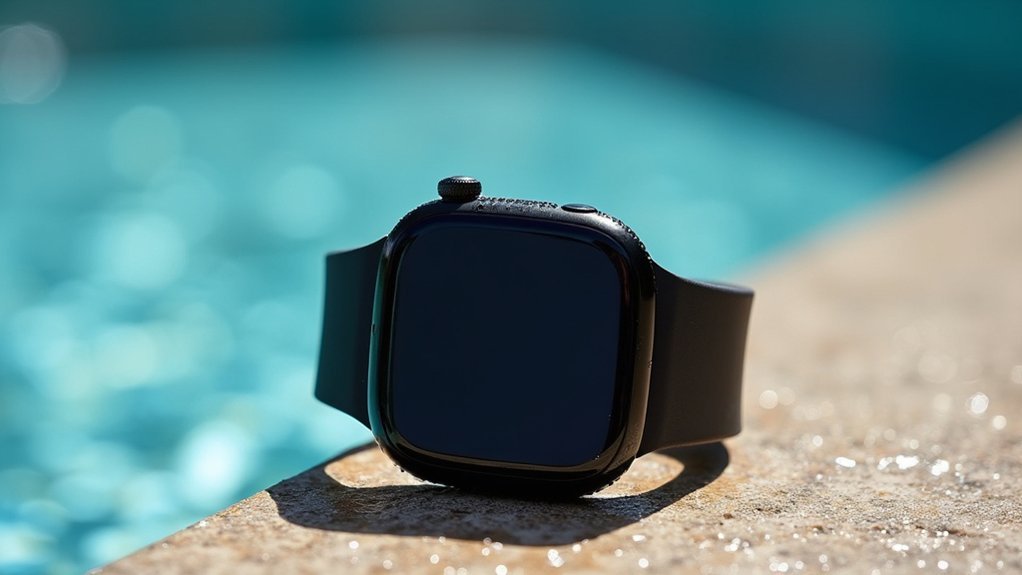
When shopping for a swimming watch, you’ll encounter three main units that describe water resistance: ATM, meters, and bars.
ATM stands for “atmosphere” and represents the pressure Earth’s atmosphere exerts at sea level. You’ll commonly see ratings like 1 ATM, 3 ATM, or 5 ATM on watch specifications.
ATM ratings on swimming watches measure atmospheric pressure resistance, with common specifications ranging from 1 ATM to 5 ATM.
Meters refer to the water depth equivalent tested in laboratory conditions. A 30-meter rating correlates to 3 ATM but doesn’t mean you can safely dive to 30 meters in real-world conditions.
Bars function as another pressure unit, with 1 BAR approximately equaling 1 ATM. European brands often use bars alongside ATM and meters.
All three units indicate static pressure tolerance, not actual diving depth recommendations for dynamic underwater activities. Real-life factors like movement and water flow create additional pressure that can affect your watch’s performance beyond the laboratory-tested ratings.
What 3 ATM and 5 ATM Ratings Actually Mean for Daily Use
While shopping for a swimming watch, you’ll discover that 3 ATM and 5 ATM ratings don’t translate directly to safe diving depths despite their meter equivalents. These ratings indicate pressure resistance, not actual swimming capabilities.
| Rating | Safe Activities | Avoid |
|---|---|---|
| 3 ATM | Hand washing, light splashes | Swimming, showering |
| 5 ATM | Swimming, showering, rain | Diving, water sports |
A 3 ATM watch handles everyday splashes and handwashing but shouldn’t be submerged. You can’t swim or shower with it safely. Meanwhile, 5 ATM watches let you swim casually and shower without worry, though they’re not meant for diving or high-velocity water activities. Remember that all watches are water-resistant, not waterproof, meaning they have limits beyond which water damage can occur.
Swimming and Snorkeling: Why 10 ATM Is the Minimum Standard
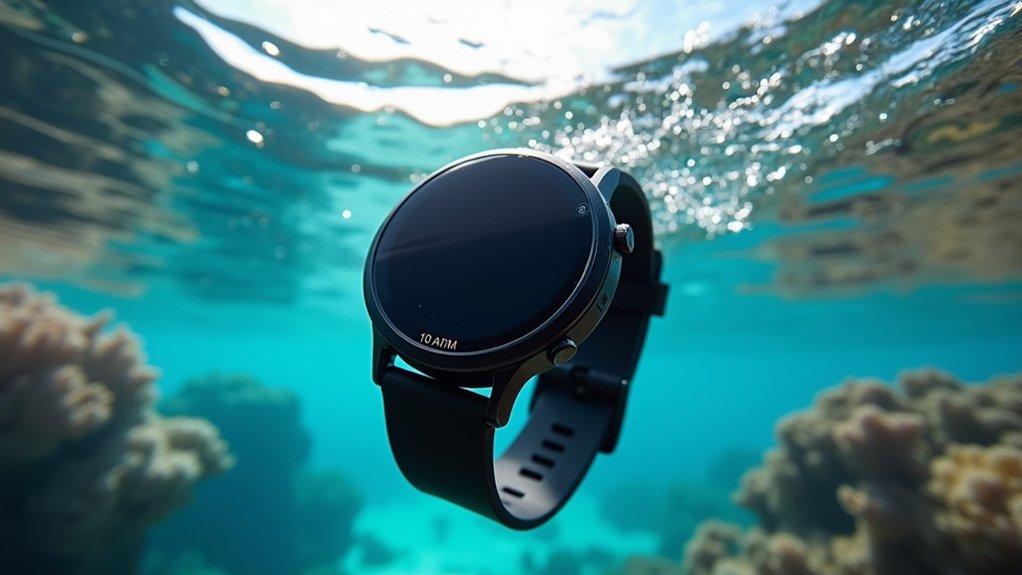
When you swim or snorkel, your watch faces dynamic water pressure that’s much more intense than the steady pressure of static water depth ratings.
Your swimming strokes create pressure spikes and sudden force changes that can overwhelm watches rated below 10 ATM, pushing water past seals that would otherwise hold under gentle conditions.
You’ll need that extra safety margin because even shallow water activities generate unpredictable pressure variations that can quickly exceed your watch’s theoretical depth rating. The 10 ATM rating provides suitable protection for snorkeling, scuba diving, and other water sports, making it a good choice for recreational divers.
Dynamic Water Pressure Effects
As you move through water while swimming or snorkeling, your watch experiences dynamic pressure—the additional force created by water flowing around the timepiece during movement.
However, this dynamic pressure won’t greatly impact your watch’s water resistance rating. Since human underwater movement speeds are limited, the additional pressure remains minimal.
ISO water resistance tests use static pressure conditions but include safety margins that account for these dynamic fluctuations.
You’ll typically experience only about 5 meters of additional equivalent depth pressure from your swimming movements.
This dynamic pressure impact is far less considerable than other factors like thermal shock or water density changes that can affect your watch’s long-term water resistance performance. Watches tested beyond their depth rating can withstand dynamic pressure effects from typical underwater activities.
Safety Margin Considerations
Understanding why 10 ATM represents the minimum standard for swimming and snorkeling requires examining how ISO safety margins protect your watch in real-world conditions. Manufacturers must build in 125% of stated pressure resistance to account for variables testing can’t replicate.
| Water Resistance | Suitable Activities | Risk Level |
|---|---|---|
| 3 ATM | Hand washing, light rain | High for swimming |
| 5 ATM | Shallow swimming only | Moderate risk |
| 10 ATM | Swimming, snorkeling | Low risk |
| 20+ ATM | All water sports | Minimal risk |
You’ll encounter pressure spikes from arm movements, waves, and thermal shock that exceed static test conditions. Lower ratings risk seal failure when exposed to saltwater corrosion and repeated temperature changes. The 10 ATM threshold guarantees your watch survives these real-world stresses.
Water resistance ratings measure pressure resistance, not the actual depth your watch can safely reach underwater.
Professional Water Sports and 20 ATM Capabilities
Professional water sports demand robust timepiece protection, and 20 ATM water resistance delivers exactly that capability.
You’ll find this 200-meter rating ideal for sailing, windsurfing, surfing, and competitive swim training where your watch faces rapid water entry and exit.
This resistance level handles the dynamic pressures created during high-intensity water activities that exceed standard 10 ATM swimming watches.
You can confidently wear your 20 ATM timepiece during skin diving and shallow free diving scenarios up to 20 meters depth.
However, don’t confuse this rating with full diving certification.
While 20 ATM covers serious surface water sports and recreational underwater activities, it’s insufficient for scuba diving or technical diving, which require stricter ISO 6425 diver’s watch standards and additional safety protocols. Water ingress can cause irreparable damage if seals fail during extreme water exposure.
Diver’s Watch Standards Vs Regular Water Resistance
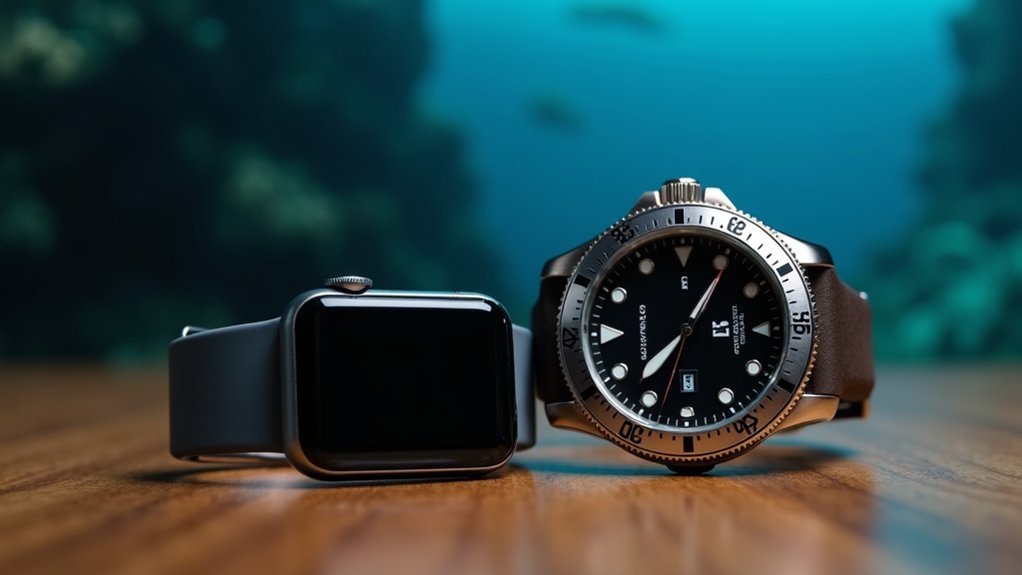
While both diver’s watches and regular water-resistant timepieces display similar depth ratings, they’re engineered for completely different purposes and performance standards.
You’ll find diver’s watches must meet ISO 6425 standards, requiring 100-meter minimum resistance and overpressure testing at 125% of rated depth. They undergo rigorous saltwater immersion, temperature variation, and multi-condition testing that regular watches don’t face.
Your regular water-resistant watch follows ISO 2281 standards, designed for daily activities like handwashing or rain exposure.
Diver’s watches include mandatory features you won’t see elsewhere: unidirectional rotating bezels, underwater legibility at 25cm, shock resistance, and specialized crown sealing systems. The certification must be conducted by an independent body accredited by ISO rather than the brand itself.
If you’re planning serious diving, don’t rely on regular water resistance ratings—they lack the safety margins and durability required for underwater environments.
Why Depth Numbers Don’t Equal Safe Diving Depth
When you see “50m water resistant” on your watch, don’t assume you can swim at 50-meter depths safely.
Those numbers represent static pressure in controlled laboratory conditions, not the dynamic forces you’ll encounter underwater.
Your swimming strokes, water currents, and temperature changes create pressures that exceed these static ratings, making real-world conditions far more demanding than lab tests suggest. Water resistance ratings indicate how much pressure a watch can handle under specific testing conditions.
Static Vs Dynamic Pressure
Unless you understand the difference between static and dynamic pressure, you’ll likely misinterpret your watch’s water resistance rating and potentially damage your timepiece underwater.
Static pressure is what manufacturers test in labs – the force water exerts when you’re motionless at a specific depth. Every 10 meters equals about 1 atmosphere of pressure. Your watch’s 100m rating reflects this controlled, static condition.
Dynamic pressure occurs when you’re actually moving through water. Swimming, diving, or water sports create additional force that can exceed your watch’s static rating.
While this dynamic effect typically adds only about 5 meters to the equivalent static depth, it’s enough to overwhelm watches used beyond their intended limits.
This explains why depth ratings don’t guarantee safe diving performance. Professional diving watches must meet ISO 6425 standards, which require resistance to at least 100 meters of water pressure and additional testing protocols beyond basic water resistance ratings.
Laboratory Vs Real Conditions
The controlled environment where manufacturers test your watch’s water resistance bears little resemblance to the chaotic conditions you’ll face in actual water activities.
Laboratory tests use static pressure in hyperbaric chambers, keeping your watch motionless for brief periods. They don’t replicate the dynamic forces you’ll encounter swimming, diving, or surfing.
Real-world water activities expose your watch to rapid pressure changes, temperature fluctuations, and water currents that stress seals beyond laboratory parameters.
When you jump into water or move your arms while swimming, G-forces magnify pressure effects on your watch’s casing.
Temperature differences between air and water cause condensation and material expansion that challenges seal integrity in ways static tests can’t predict. Many manufacturers conduct dry pressure tests that don’t even involve actual water contact, further widening the gap between laboratory ratings and real-world performance.
Dynamic Water Pressure Vs Static Laboratory Testing
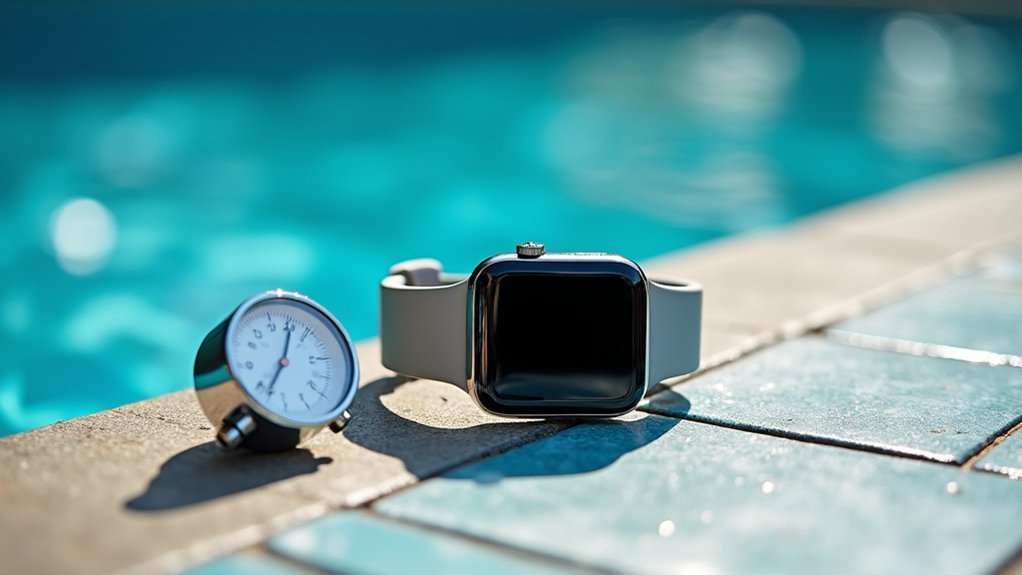
Understanding your swimming watch’s water resistance rating requires recognizing an essential distinction that manufacturers don’t always emphasize clearly.
Static laboratory testing measures your watch’s resistance to constant pressure in controlled environments, simulating still water conditions. However, dynamic water pressure from real swimming, diving, or water sports creates entirely different forces.
Laboratory water resistance tests can’t replicate the dynamic pressures your watch faces during actual swimming and water sports activities.
When you’re actively moving in water, dynamic pressure generates forces several times greater than static ratings suggest. Your arm movements, water impact, and sudden depth changes create pressure spikes that laboratory tests can’t accurately replicate. This means your watch rated for 50 meters might struggle during actual swimming activities.
Static tests use pressurized chambers to verify seals, but they can’t simulate the variable, fluctuating loads you’ll encounter during real water activities. Manufacturers conduct rigorous testing to determine these ratings, but even comprehensive laboratory conditions cannot fully replicate the unpredictable nature of dynamic water exposure.
Choosing the Right Water Resistance Rating for Your Activities
When selecting a water resistance rating for your swimming watch, you’ll need to match the numerical specifications to your actual water activities rather than assuming higher numbers automatically mean better performance.
Consider your primary activities when choosing ratings:
- Casual swimmers: 10 ATM/100 meters handles recreational swimming, snorkeling, and water sports effectively.
- Professional marine workers: 20 ATM/200 meters suits surface water sports and skin diving demands.
- Scuba divers: Certified diver’s ratings (200M/300M) meet strict diving standards with proper helium escape valves.
Your usage frequency matters too. Daily water exposure requires stronger resistance than occasional splashes.
Don’t forget that watch construction affects performance—screw-down crowns and sealed gaskets enhance protection. Water resistance is measured in atmosphere (ATM) or bar, with one atmosphere equaling about 10 meters or roughly 30 feet.
Remember that water resistance degrades over time, so regular maintenance keeps your watch performing reliably.
Frequently Asked Questions
Does Water Temperature Affect My Watch’s Water Resistance Rating?
Yes, water temperature affects your watch’s water resistance. Hot water degrades seals faster, while temperature changes cause materials to expand and contract, creating gaps that compromise waterproofing despite stated ratings.
How Often Should I Replace Gaskets to Maintain Water Resistance?
You should replace watch gaskets every 3-5 years for regular use, but every 2-3 years if you’re frequently swimming or diving. Check annually for signs like fogging or decreased water resistance.
Can I Wear My Water-Resistant Watch in a Hot Tub?
You shouldn’t wear your water-resistant watch in a hot tub. The combination of high heat, chemicals, and water degrades seals and gaskets, potentially causing water damage even with good ratings.
Will Soap or Shampoo Damage My Watch’s Water Resistance Seals?
Soap and shampoo won’t typically damage your watch’s water resistance seals since modern seals resist mild chemicals. However, you should rinse your watch with fresh water afterward to prevent buildup.
Does Altitude Affect Water Resistance Ratings in Mountain Lakes?
Altitude doesn’t change your watch’s water resistance rating since hydrostatic pressure depends on water depth, not elevation. However, lower atmospheric pressure at altitude can affect seal performance and compromise water resistance.
In Summary
You’ll want to match your watch’s water resistance rating to your actual activities rather than assuming depth numbers guarantee safety. Don’t rely on 3-5 ATM ratings for swimming—you’ll need at least 10 ATM for pool activities and 20 ATM for serious water sports. Remember that dynamic water pressure differs considerably from laboratory testing conditions. Always choose a higher rating than you think you’ll need, and you’ll protect your investment while enjoying worry-free water activities.

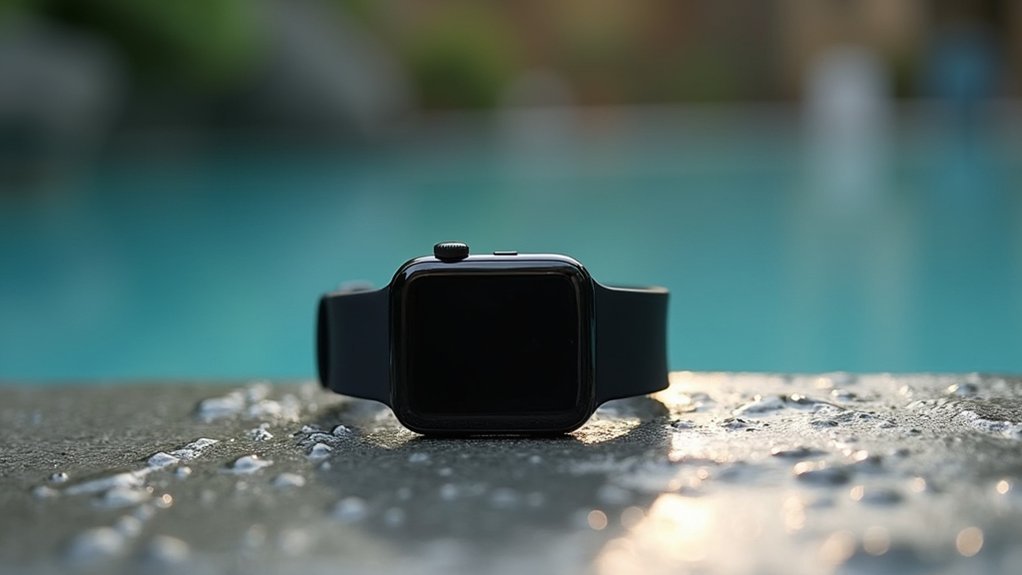



Leave a Reply